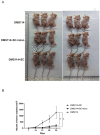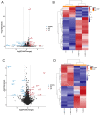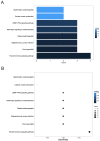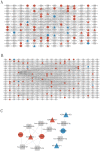A Novel Therapeutic Target for Small-Cell Lung Cancer: Tumor-Associated Repair-like Schwann Cells
- PMID: 36551618
- PMCID: PMC9776631
- DOI: 10.3390/cancers14246132
A Novel Therapeutic Target for Small-Cell Lung Cancer: Tumor-Associated Repair-like Schwann Cells
Abstract
Small-cell lung cancer (SCLC), representing 15-20% of all lung cancers, is an aggressive malignancy with a distinct natural history, poor prognosis, and limited treatment options. We have previously identified Schwann cells (SCs), the main glial cells of the peripheral nervous system, in tumor tissues and demonstrated that they may support tumor spreading and metastasis formation in the in vitro and in vivo models. However, the role of SCs in the progression of SCLC has not been investigated. To clarify this issue, the cell proliferation assay, the annexin V apoptosis assay, and the transwell migration and invasion assay were conducted to elucidate the roles in SCLC of tumor-associated SCs (TA-SCs) in the proliferation, apoptosis, migration, and invasion of SCLC cells in vitro, compared to control group. In addition, the animal models to assess SC action's effects on SCLC in vivo were also developed. The result confirmed that TA-SCs have a well-established and significant role in facilitating SCLC cell cancer migration and invasion of SCLC in vitro, and we also observed that SC promotes tumor growth of SCLC in vivo and that TA-SCs exhibited an advantage and show a repair-like phenotype, which allowed defining them as tumor-associated repair SCs (TAR-SCs). Potential molecular mechanisms of pro-tumorigenic activity of TAR-SCs were investigated by the screening of differentially expressed genes and constructing networks of messenger-, micro-, and long- non-coding RNA (mRNA-miRNA-lncRNA) using DMS114 cells, a human SCLC, stimulated with media from DMS114-activated SCs, non-stimulated SCs, and appropriate controls. This study improves our understanding of how SCs, especially tumor-activated SCs, may promote SCLC progression. Our results highlight a new functional phenotype of SCs in cancer and bring new insights into the characterization of the nervous system-tumor crosstalk.
Keywords: Schwann cells; gene expression; miRNA; small-cell lung cancer; tumor progression.
Conflict of interest statement
The authors declare no conflict of interest.
Figures













Similar articles
-
Tumor-neuroglia interaction promotes pancreatic cancer metastasis.Theranostics. 2020 Apr 6;10(11):5029-5047. doi: 10.7150/thno.42440. eCollection 2020. Theranostics. 2020. PMID: 32308766 Free PMC article.
-
Cepharanthine as an effective small cell lung cancer inhibitor: integrated insights from network pharmacology, RNA sequencing, and experimental validation.Front Pharmacol. 2024 Nov 28;15:1517386. doi: 10.3389/fphar.2024.1517386. eCollection 2024. Front Pharmacol. 2024. PMID: 39669201 Free PMC article.
-
LncRNA SNHG16 promotes Schwann cell proliferation and migration to repair sciatic nerve injury.Ann Transl Med. 2021 Aug;9(16):1349. doi: 10.21037/atm-21-3971. Ann Transl Med. 2021. PMID: 34532486 Free PMC article.
-
Role of microRNAs in regulating cell proliferation, metastasis and chemoresistance and their applications as cancer biomarkers in small cell lung cancer.Biochim Biophys Acta Rev Cancer. 2021 Aug;1876(1):188552. doi: 10.1016/j.bbcan.2021.188552. Epub 2021 Apr 21. Biochim Biophys Acta Rev Cancer. 2021. PMID: 33892053 Review.
-
Clinical relevance of stem cells in lung cancer.World J Stem Cells. 2023 Jun 26;15(6):576-588. doi: 10.4252/wjsc.v15.i6.576. World J Stem Cells. 2023. PMID: 37424954 Free PMC article. Review.
Cited by
-
Schwann cells in the normal and pathological lung microenvironment.Front Mol Biosci. 2024 Apr 4;11:1365760. doi: 10.3389/fmolb.2024.1365760. eCollection 2024. Front Mol Biosci. 2024. PMID: 38638689 Free PMC article. Review.
-
Cost-effectiveness analysis of adebrelimab in combination with chemotherapy for first-line treatment of extensive-stage small cell lung cancer.PLoS One. 2025 Jun 13;20(6):e0325171. doi: 10.1371/journal.pone.0325171. eCollection 2025. PLoS One. 2025. PMID: 40512778 Free PMC article.
-
PTPMT1 inhibition induces apoptosis and growth arrest of human SCLC cells by disrupting mitochondrial metabolism.Transl Cancer Res. 2024 Dec 31;13(12):6956-6969. doi: 10.21037/tcr-2024-2379. Epub 2024 Dec 27. Transl Cancer Res. 2024. PMID: 39816544 Free PMC article.
-
Schwann cells in regeneration and cancer.Front Pharmacol. 2025 Jan 29;16:1506552. doi: 10.3389/fphar.2025.1506552. eCollection 2025. Front Pharmacol. 2025. PMID: 39981185 Free PMC article. Review.
-
N6-methyladenosine modification of OIP5-AS1 promotes glycolysis, tumorigenesis, and metastasis of gastric cancer by inhibiting Trim21-mediated hnRNPA1 ubiquitination and degradation.Gastric Cancer. 2024 Jan;27(1):49-71. doi: 10.1007/s10120-023-01437-7. Epub 2023 Oct 28. Gastric Cancer. 2024. PMID: 37897508 Free PMC article.
References
LinkOut - more resources
Full Text Sources

